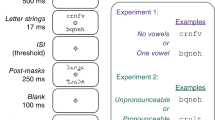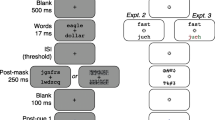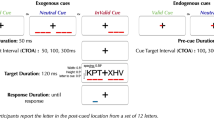Abstract
In this work, we develop an empirically driven model of visual attention to multiple words using the word–word interference (WWI) task. In this task, two words are simultaneously presented visually: a to-be-ignored distractor word at fixation, and a to-be-read-aloud target word above or below the distractor word. Experiment 1 showed that low-frequency distractor words interfere more than high-frequency distractor words. Experiment 2 showed that distractor frequency (high vs. low) and target frequency (high vs. low) exert additive effects. Experiment 3 showed that the effect of the case status of the target (same vs. AlTeRnAtEd) interacts with the type of distractor (word vs. string of # marks). Experiment 4 showed that targets are responded to faster in the presence of semantically related distractors than in presence of unrelated distractors. Our model of visual attention to multiple words borrows two principles governing processing dynamics from the dual-route cascaded model of reading: cascaded interactive activation and lateral inhibition. At the core of the model are three mechanisms aimed at dealing with the distinctive feature of the WWI task, which is that two words are presented simultaneously. These mechanisms are identification, tokenization, and deactivation.
Similar content being viewed by others
References
Allport, D. A. (1977). On knowing the meaning of words we are unable to report: The effects of visual masking. In S. Dornic (Ed.), Attention and performance VI (pp. 505–533). Hillsdale, NJ: Erlbaum.
Ayora, P., Peressotti, F., Alario, F.-X., Mulatti, C., Pluchino, P., Job, R., & Dell’Acqua, R. (2011). What phonological facilitation tells about semantic interference: A dual-task study. Frontiers in Language Sciences, 2(57), 1–10. doi:10.3389/fpsyg.2011.00057
Besner, D., & McCann, R. S. (1987). Word frequency and pattern distortion in visual word identification and production: An examination of four classes of models. In M. Coltheart (Ed.), Attention and performance XII (pp. 201–219). Hillsdale, NJ: Erlbaum.
Bowman, H., & Wyble, B. (2007). The simultaneous type, serial token model of temporal attention and working memory. Psychological Review, 114, 38–70. doi:10.1037/0033-295X.114.1.38
Chun, M. M. (1997). Types and tokens in visual processing: A double dissociation between the attentional blink and repetition blindness. Journal of Experimental Psychology: Human Perception and Performance, 23, 738–755. doi:10.1037/0096-1523.23.3.738
Coltheart, M., Rastle, K., Perry, C., Langdon, R., & Ziegler, J. (2001). DRC: A dual route cascaded model of visual word recognition and reading aloud. Psychological Review, 108, 204–256. doi:10.1037/0033-295X.108.1.204
Glaser, W. R., & Glaser, M. O. (1989). Context effects in Stroop-like word and picture processing. Journal of Experimental Psychology: General, 118, 13–42. doi:10.1037/0096-3445.118.1.13
Hayworth, K.J. (2009). Explicit encoding of spatial relations in the human visual system: Evidence from functional neuroimaging (Doctoral dissertation). Available from ProQuest Dissertations and Theses database. (UMI No. 3389612)
Hayworth, K.J., Lescroart, M. D., & Biederman, I. (2011). Neural encoding of relative position. Journal of Experimental Psychology: Human Perception and Performance, 37, 1032–1050.
Jackendoff, R. (1983). Semantics and cognition. Cambridge, MA: MIT Press.
Kahneman, D., Treisman, A., & Gibbs, B. J. (1992). The reviewing of object files: Object-specific integration of information. Cognitive Psychology, 24, 175–219. doi:10.1016/0010-0285(92)90007-O
Kanwisher, N. G. (1987). Repetition blindness: Type recognition without token individuation. Cognition, 27, 117–143. doi:10.1016/0010-0277(87)90016-3
Kanwisher, N. G. (1991). Repetition blindness and illusory conjunctions: Errors in binding visual types with visual tokens. Journal of Experimental Psychology: Human Perception and Performance, 17, 404–421. doi:10.1037/0096-1523.17.2.404
La Heij, W. (1988). Components of Stroop-like interference in picture naming. Memory & Cognition, 16, 400–410. doi:10.3758/BF03214220
La Heij, W., Happel, B., & Mulder, M. (1990). Components of Stroop-like interference in word reading. Acta Psychologica, 73, 115–129.
Laudanna, A., Thornton, A. M., Brown, G., Burani, C., & Marconi, L. (1995). In S. Bolasco, L. Lebart, & A. Salem (Eds.), III Giornate internazionali di Analisi Statistica dei Dati Testuali (Vol. I, pp. 103–109). Rome. Italy: Cisu.
Levelt, W. J. M., Roelofs, A., & Meyer, A. S. (1999). A theory of lexical access in speech production. Behavioral and Brain Sciences, 22, 1–38, disc. 38–75.
Mayall, K., Humphreys, G. W., & Olson, A. (1997). Disruption to word or letter processing? The origins of case-mixing effects. Journal of Experimental Psychology: Learning, Memory, and Cognition, 23, 1275–1286. doi:10.1037/0278-7393.23.5.1275
McCauley, C., Parmelee, C. M., Sperber, R. D., & Carr, T. H. (1980). Early extraction of meaning from pictures and its relation to conscious identification. Journal of Experimental Psychology: Human Perception and Performance, 6, 265–276. doi:10.1037/0096-1523.6.2.265
McClelland, J. L. (1986). The programmable blackboard model of reading. In J. L. McClelland & D. E. Rumelhart (Eds.), Parallel distributed processing: Explorations in the microstructure of cognition (Vol. 2, pp. 122–169). Cambridge, MA: MIT Press.
McClelland, J. L., & Elman, J. L. (1986). The TRACE model of speech perception. Cognitive Psychology, 18, 1–86. doi:10.1016/0010-0285(86)90015-0
Miozzo, M., & Caramazza, A. (2003). When more is less: A counterintuitive effect of distractor frequency in the picture–word interference paradigm. Journal of Experimental Psychology: General, 132, 228–252. doi:10.1037/0096-3445.132.2.228
Monsell, S., Taylor, T. J., & Murphy, K. (2001). Naming the color of a word: Is it responses or task sets that compete? Memory & Cognition, 29, 137–151.
Morton, J. (1969). Interaction of information in word recognition. Psychological Review, 76, 165–178. doi:10.1037/h0027366
Mulatti, C., Lotto, L., Peressotti, F., & Job, R. (2010). Speed of processing explains the picture—Word asymmetry in conditional naming. Psychological Research, 74, 71–81.
Mulatti, C., Peressotti, F., Job, R., Saunders, S., & Coltheart, M. (2012). Reading aloud: The cumulative lexical interference effect. Psychonomic Bulletin & Review, 19, 662–667. doi:10.3758/s13423-012-0269-z
Neumann, O. (1986). Facilitative and inhibitory effects of “semantic relatedness” (Report No. 111/1986). , Bielefeld, Germany: University of Bielefeld, “Perception and Action” Research Group.
Perea, M., & Rosa, E. (2000). The effects of orthographic neighborhood in reading and laboratory word identification tasks: A review. Psicológica, 21, 327–340.
Roelofs, A. (2003). Goal-referenced selection of verbal action: Modeling attentional control in the Stroop task. Psychological Review, 110, 88–125. doi:10.1037/0033-295X.110.1.88
Roelofs, A. (2004). Seriality of phonological encoding in naming objects and reading their names. Memory & Cognition, 32, 212–222.
Schmidt, J. R., Cheesman, J., & Besner, D. (2013). You can’t Stroop a lexical decision: Is semantic processing fundamentally facilitative? Canadian Journal of Experimental Psychology, 67, 130–139.
Treccani, B., Cubelli, R., Sellaro, R., Umiltà, C., & Della Sala, S. (2012). Dissociation between awareness and spatial coding: Evidence from unilateral neglect. Journal of Cognitive Neuroscience, 24, 854–867.
Van Selst, M., & Jolicœur, P. (1994). A solution to the effect of sample size on outlier elimination. Quarterly Journal of Experimental Psychology, 47A, 631–650. doi:10.1080/14640749408401131
Warren, C., & Morton, J. (1982). The effects of priming on picture recognition. British Journal of Psychology, 73, 117–129.
Author information
Authors and Affiliations
Corresponding author
Rights and permissions
About this article
Cite this article
Mulatti, C., Ceccherini, L. & Coltheart, M. What can we learn about visual attention to multiple words from the word–word interference task?. Mem Cogn 43, 121–132 (2015). https://doi.org/10.3758/s13421-014-0450-x
Published:
Issue Date:
DOI: https://doi.org/10.3758/s13421-014-0450-x




